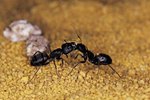Rattle snakes are among the most deadly venomous snakes living in the United States. They are responsible for a majority of the snakebites in North America due to their instinct to stand their ground and warn the threat (whether person or animal) to back away by rattling their tails. The amount of time it takes for a person to die, if at all, from a rattlesnake bite depends on his body size, weight and time between bite and treatment. Many people make a full recoveries from snakebites.
Affects of Rattlesnake Bite
Rattlesnake venom contains two types of toxins: hemotoxic and neurotoxic. Hemotoxic (hemo meaning blood) attacks blood cells and skin tissue. The breaking down of tissue causes internal hemorrhaging, or bleeding. Neurotoxins (neuro meaning nerves) targets the nervous system, which regulates the functioning of vital organs and sends messages to muscles. It is more common for rattlesnake venom to contain hemotoxins than neurotoxins, but there is no guarantee how potent any particular snake venom is going to be until bitten. If bitten by a snake with more neurotoxins than hemotoxins, you will die quicker, between a couple hours and a couple days later, due to its attack on the heart muscle, if you do not receive antivenin.
Injection of Venom
Once a rattlesnake decides to attack, the venom takes only seconds to travel from their retractable fangs, through the victim's skin and into the person or animal's body. Your natural reaction should be to pull the bitten body part away from the snake and get as far away as possible to avoid being bitten again. Even with the quickest of reactions, the venom has entered your blood stream and muscles. You must begin forming a plan of action for treating yourself. You will see symptoms immediately, but will not die immediately.
Immediate Treatment
Once bitten, begin first aid treatment on yourself immediately. Wash the bite with soap and water to prevent an infection. Do not move the affected area or the venom will spread even more quickly through your muscles and bloodstream. Keep the limb lower than your heart to prevent the venom from rushing quickly to it and other vital organs. The bite area will swell. So remove tight clothing and jewelry close to the bite. Call emergency medical help immediately. If you are able to call emergency help immediately, you are significantly less likely to die from the bite. Without treatment, the body's systems will break down over the course of two to three days, ending in death.
Lack of Medical Help
If you cannot make it to an emergency room with an antivenin within 30 minutes, tie a tight bandage a couple of inches above the bite location. This slows the dissemination of the venom. Do not cut off your circulation or you will damage the healthy tissue not receiving the proper amount of blood below the bandage. Do not suck the venom out of the bite with your mouth. Use a commercial suction device found in snakebite kits. If you do not seek medical attention, you can feel muscle pain, weakness, dizziness, blurred vision, fever, rapid pulse, nausea and severe pain at the bite location. Do not ice a snakebite. Going without medical treatment can result in death within the day or the following day due to the venom disrupting your blood flow and function of vital organs.
References
Resources
Photo Credits
-
Jupiterimages/Photos.com/Getty Images





